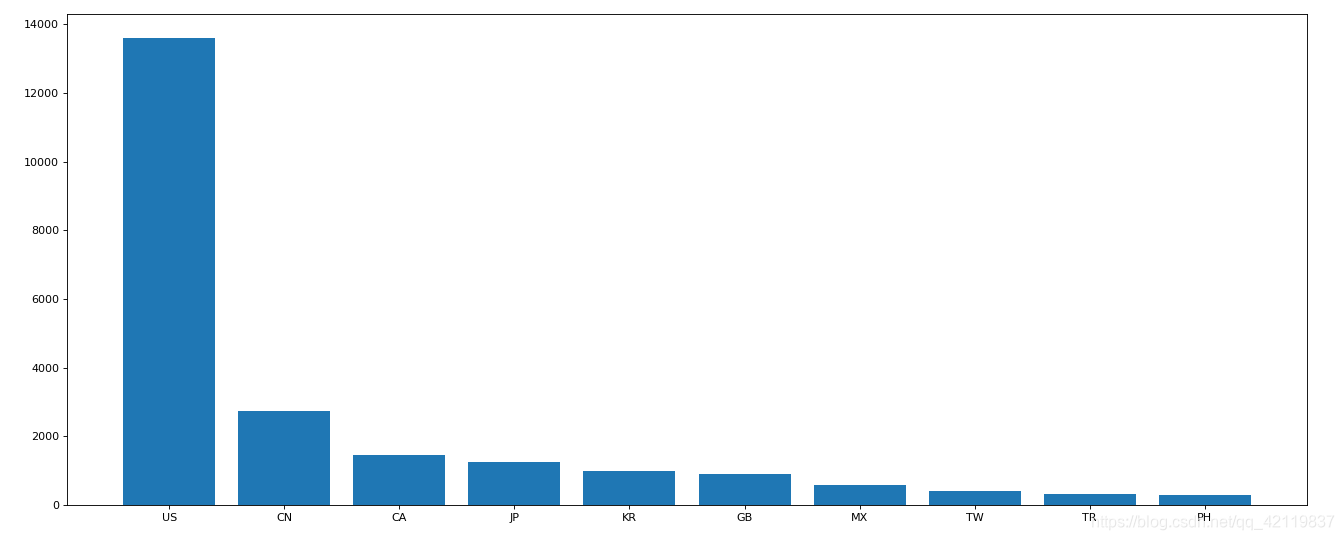目录
groupby分组
例如:grouped=df.groupby(by="columns_name") #df中的数据按照"columns_name"这列进行分组
- grouped是一个DataFrameGroupBy对象,是可迭代的
- grouped中的每一个元素是一个元组,元组里面包含的是(索引(分组的值),分组之后的DataFrame
#coding=utf-8
import pandas as pd
file_path="./directory.csv"
df=pd.read_csv(file_path)
#print(df.head(1))
#print(df.info())
grouped=df.groupby(by="Country") #按国家进行分组
print(grouped)
print(type(grouped))
运行结果:
<pandas.core.groupby.generic.DataFrameGroupBy object at 0x0000021FE373E148>
<class 'pandas.core.groupby.generic.DataFrameGroupBy'>注意:只对数据集进行分组操作,将不会显示结果,只会生成一个分组的对象,只有分组后进行聚合运算才有实际结果
聚合运算
DataFrameGroupBy对象有很多经过优化的方法

#调用聚合方法
# 单个条件分组,再按照某列进行统计
country_count=df.groupby(by="Country")["Brand"].count()
#数据按照多个条件进行分组,在对"Brand"标签这列进行统计
grouped=df["Brand"].groupby(by=[df["Country"],df["State/Province"]]).count()
print(grouped)
print(type(grouped))
print("-"*100)
#数据按照多个条件进行分组,返回DataFrame(有3种写法)
grouped1=df[["Brand"]].groupby(by=[df["Country"],df["State/Province"]]).count()
grouped2=df.groupby(by=[df["Country"],df["State/Province"]])[["Brand"]].count()
grouped3=df.groupby(by=[df["Country"],df["State/Province"]]).count()[["Brand"]]
print(grouped1,type(grouped1))
print("*"*100)
print(grouped2,type(grouped2))
print("+"*100)
print(grouped3,type(grouped3))
#前者grouped的数据类型是<class 'pandas.core.series.Series'>
#而grouped1,grouped2,grouped3都是<class 'pandas.core.frame.DataFrame'>索引和复合索引
简单的索引操作:
•
获取
index
:
df.index
•
指定
index
:
df.index
=
['
x','y
']
•
重新设置
index
:
df.reindex
(list("
abcedf
"))
•
指定某一
列的内容作为
index
:
df.set_index
("
Country",drop=False) #
drop
为假表示保留之前列充当索引的列,默认情况下充当索引的列"Country"删除
•
返回
index
的唯一值:
df.set_index
("Country").
index.unique
() #unique()可以对index去除重复值
例题:
假设a为一个DataFrame,那么当a.set_index(["c","d"])即设置两个索引的时候是什么样子的结果呢?另外Series和DataFrame类型复合索引取值有什么区别呢?
a = pd.DataFrame({'a': range(7),'b': range(7, 0, -1),'c': ['one','one','one','two','two','two', 'two'],'d': list("hjklmno")})
In [1]: import pandas as pd
In [2]: a = pd.DataFrame({'a': range(7),'b': range(7, 0, -1),'c': ['one','one','one','two','two','two', 'two'],'d': lis
...: t("hjklmno")})
In [3]: a
Out[3]:
a b c d
0 0 7 one h
1 1 6 one j
2 2 5 one k
3 3 4 two l
4 4 3 two m
5 5 2 two n
6 6 1 two o
In [5]: b= a.set_index(["c","d"])
In [6]: b
Out[6]:
a b
c d
one h 0 7
j 1 6
k 2 5
two l 3 4
m 4 3
n 5 2
o 6 1
In [7]: c=b["a"]
In [8]: c
Out[8]:
c d
one h 0
j 1
k 2
two l 3
m 4
n 5
o 6
Name: a, dtype: int64
In [9]: type(c)
Out[9]: pandas.core.series.Series
#对Series类型取索引,直接在中括号里写索引标签就可以了
In [10]: c["one"]["j"]
Out[10]: 1
In [11]: c["one"]
Out[11]:
d
h 0
j 1
k 2
Name: a, dtype: int64
#对DataFrame类型取索引,需要使用loc通过标签索引行数据
In [15]: type(b)
Out[15]: pandas.core.frame.DataFrame
In [16]: b
Out[16]:
a b
c d
one h 0 7
j 1 6
k 2 5
two l 3 4
m 4 3
n 5 2
o 6 1
In [17]: b.loc["one"]
Out[17]:
a b
d
h 0 7
j 1 6
k 2 5
In [18]: b.loc["one"].loc["h"]
Out[18]:
a 0
b 7
Name: h, dtype: int64
#对于复合索引,如果想单独获取内层索引的值,就需要用到swaplevel()交换内外层索引,再通过loc来获取索引标签下的值
In [19]: b.swaplevel()
Out[19]:
a b
d c
h one 0 7
j one 1 6
k one 2 5
l two 3 4
m two 4 3
n two 5 2
o two 6 1
In [20]: b.swaplevel().loc["h"]
Out[20]:
a b
c
one 0 7练习:
1.
使用
matplotlib
呈现出店铺总数排名前
10
的国家
#coding=utf-8
import pandas as pd
from matplotlib import pyplot as plt
file_path="./directory.csv"
df=pd.read_csv(file_path)
# print(df.head(1))
# print(df.info())
#准备数据,按国家进行分组,并统计各个国家星巴克的数量;再排序,以降序排列,选取前10名
data1=df.groupby(by="Country")["Brand"].count().sort_values(ascending=False)[:10]
_x=data1.index
_y=data1.values
#画图
plt.figure(figsize=(20,8),dpi=80)
plt.bar(range(len(_x)),_y)
#设置x轴坐标
plt.xticks(range(len(_x)),_x)
plt.show()
2.
使用
matplotlib
呈现出中国每个城市的店铺数量
#使用matplotlib呈现出中国每个城市的店铺数量
#coding=utf-8
import pandas as pd
from matplotlib import pyplot as plt
from matplotlib import font_manager
#设置中文字体
my_font = font_manager.FontProperties(fname=r"D:\anaconda\Lib\site-packages\matplotlib\mpl-data\fonts\ttf\msyh.ttc")
file_path="./directory.csv"
df=pd.read_csv(file_path)
# print(df.head(1))
# print(df.info())
#准备数据,先通过布尔索引选定中国的数据,再按城市进行分组统计;再排序,以降序排列,选取前20名
data1=df[df["Country"]=="CN"].groupby(by="City")["Brand"].count().sort_values(ascending=False)[:20]
print(data1)
_x=data1.index
_y=data1.values
#画图
plt.figure(figsize=(20,8),dpi=80)
plt.bar(range(len(_x)),_y,width=0.3,color="orange")
#设置x轴坐标
plt.xticks(range(len(_x)),_x,fontproperties=my_font)
plt.show()
3.现在我们有全球排名靠前的10000本书的数据,那么请统计一下下面几个问题:
1.
不同年份书的数量
2.
不同年份书的平均评分情况
#coding=utf-8
import pandas as pd
from matplotlib import pyplot as plt
from matplotlib import font_manager
file_path="./books.csv"
df=pd.read_csv(file_path)
#print(df.info())
#统计不同年份书的数量
data1=df[pd.notnull(df["original_publication_year"])] #去除nan的行
# grouped=data1.groupby(by="original_publication_year").count()["title"]
#统计不同年份书的平均评分情况
grouped1=data1.groupby(by="original_publication_year")["average_rating"].mean()
# print(grouped1)
_x=grouped1.index
_y=grouped1.values
#画图
plt.figure(figsize=(20,8),dpi=80)
plt.plot(range(len(_x)),_y)
print(len(_x),len(_y))
#设置x轴刻度
plt.xticks(list(range(len(_x)))[::10],_x[::10].astype(int),rotation=45)
plt.show()






















 734
734











 被折叠的 条评论
为什么被折叠?
被折叠的 条评论
为什么被折叠?








